Emerging Diseases and the Role of EMS During Disasters: A Report
VerifiedAdded on 2022/09/14
|14
|3782
|15
Report
AI Summary
This report delves into the critical issue of emerging diseases that arise following disasters, both natural and human-made, and examines the pivotal role of Emergency Medical Services (EMS) in mitigating their impact. The paper explores the various causes of disease outbreaks post-disaster, including environmental changes, compromised sanitation, and overcrowding. It identifies specific diseases, such as diarrhea, hepatitis, leptospirosis, measles, acute respiratory infections, and vector-borne diseases like malaria and dengue, highlighting the factors that contribute to their spread. Furthermore, the report emphasizes the importance of EMS in providing pre-hospital care, disseminating information, and implementing preventive measures such as safe water management, hygiene promotion, vaccination programs, and primary healthcare services. The report underscores the need for effective disease management strategies, including early warning systems and adherence to international guidelines, to safeguard public health during and after disaster events.
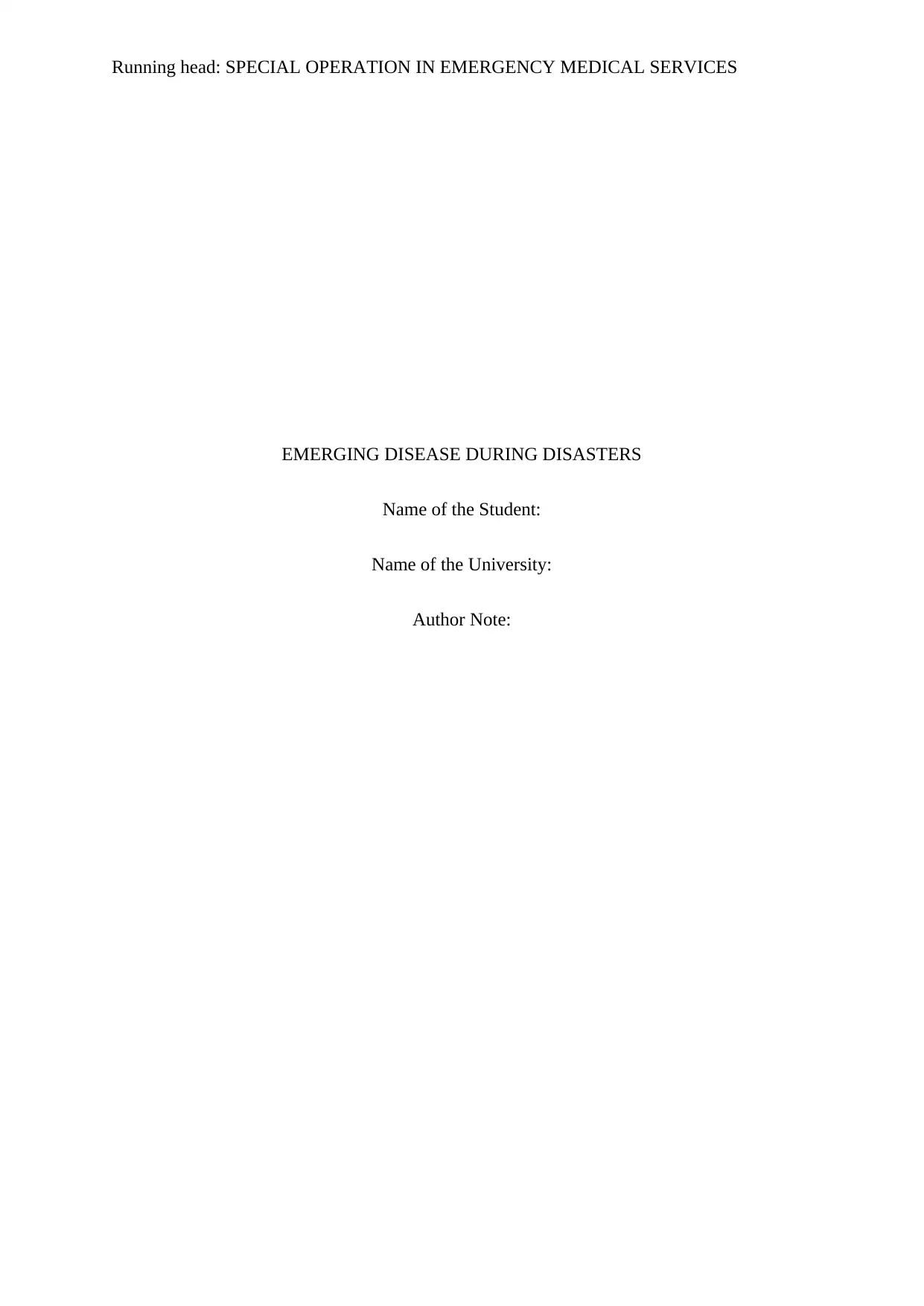
Running head: SPECIAL OPERATION IN EMERGENCY MEDICAL SERVICES
EMERGING DISEASE DURING DISASTERS
Name of the Student:
Name of the University:
Author Note:
EMERGING DISEASE DURING DISASTERS
Name of the Student:
Name of the University:
Author Note:
Paraphrase This Document
Need a fresh take? Get an instant paraphrase of this document with our AI Paraphraser
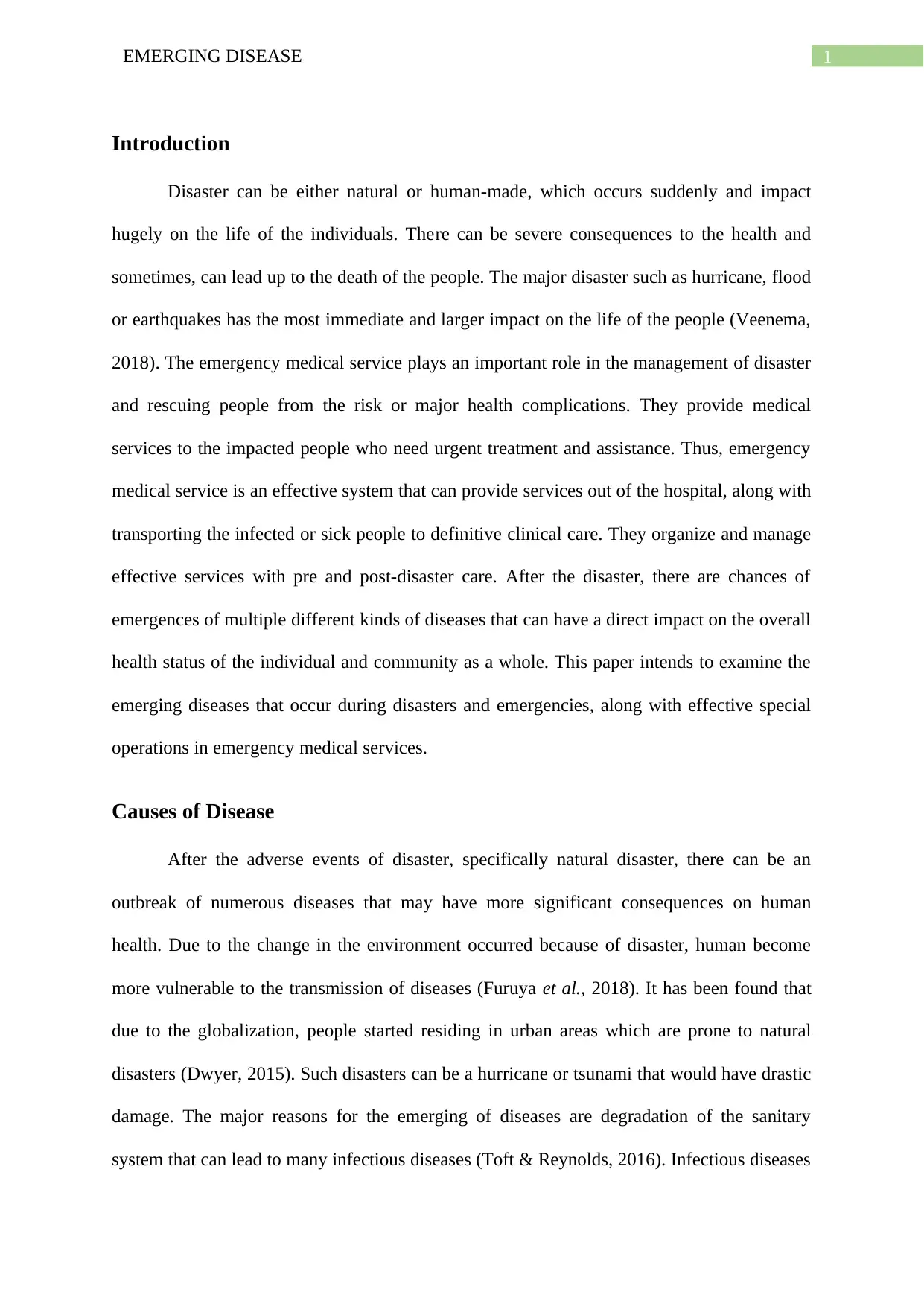
1EMERGING DISEASE
Introduction
Disaster can be either natural or human-made, which occurs suddenly and impact
hugely on the life of the individuals. There can be severe consequences to the health and
sometimes, can lead up to the death of the people. The major disaster such as hurricane, flood
or earthquakes has the most immediate and larger impact on the life of the people (Veenema,
2018). The emergency medical service plays an important role in the management of disaster
and rescuing people from the risk or major health complications. They provide medical
services to the impacted people who need urgent treatment and assistance. Thus, emergency
medical service is an effective system that can provide services out of the hospital, along with
transporting the infected or sick people to definitive clinical care. They organize and manage
effective services with pre and post-disaster care. After the disaster, there are chances of
emergences of multiple different kinds of diseases that can have a direct impact on the overall
health status of the individual and community as a whole. This paper intends to examine the
emerging diseases that occur during disasters and emergencies, along with effective special
operations in emergency medical services.
Causes of Disease
After the adverse events of disaster, specifically natural disaster, there can be an
outbreak of numerous diseases that may have more significant consequences on human
health. Due to the change in the environment occurred because of disaster, human become
more vulnerable to the transmission of diseases (Furuya et al., 2018). It has been found that
due to the globalization, people started residing in urban areas which are prone to natural
disasters (Dwyer, 2015). Such disasters can be a hurricane or tsunami that would have drastic
damage. The major reasons for the emerging of diseases are degradation of the sanitary
system that can lead to many infectious diseases (Toft & Reynolds, 2016). Infectious diseases
Introduction
Disaster can be either natural or human-made, which occurs suddenly and impact
hugely on the life of the individuals. There can be severe consequences to the health and
sometimes, can lead up to the death of the people. The major disaster such as hurricane, flood
or earthquakes has the most immediate and larger impact on the life of the people (Veenema,
2018). The emergency medical service plays an important role in the management of disaster
and rescuing people from the risk or major health complications. They provide medical
services to the impacted people who need urgent treatment and assistance. Thus, emergency
medical service is an effective system that can provide services out of the hospital, along with
transporting the infected or sick people to definitive clinical care. They organize and manage
effective services with pre and post-disaster care. After the disaster, there are chances of
emergences of multiple different kinds of diseases that can have a direct impact on the overall
health status of the individual and community as a whole. This paper intends to examine the
emerging diseases that occur during disasters and emergencies, along with effective special
operations in emergency medical services.
Causes of Disease
After the adverse events of disaster, specifically natural disaster, there can be an
outbreak of numerous diseases that may have more significant consequences on human
health. Due to the change in the environment occurred because of disaster, human become
more vulnerable to the transmission of diseases (Furuya et al., 2018). It has been found that
due to the globalization, people started residing in urban areas which are prone to natural
disasters (Dwyer, 2015). Such disasters can be a hurricane or tsunami that would have drastic
damage. The major reasons for the emerging of diseases are degradation of the sanitary
system that can lead to many infectious diseases (Toft & Reynolds, 2016). Infectious diseases
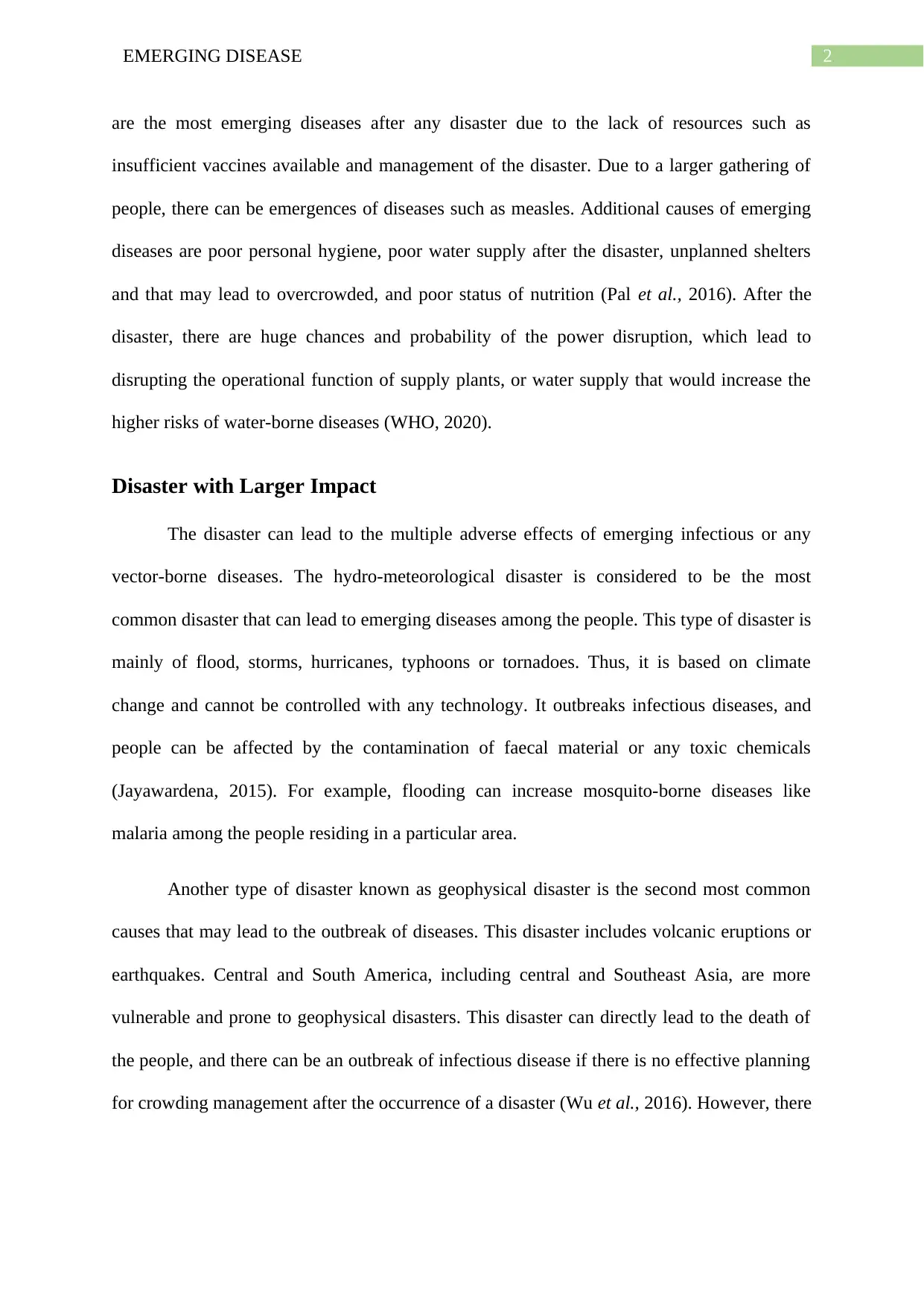
2EMERGING DISEASE
are the most emerging diseases after any disaster due to the lack of resources such as
insufficient vaccines available and management of the disaster. Due to a larger gathering of
people, there can be emergences of diseases such as measles. Additional causes of emerging
diseases are poor personal hygiene, poor water supply after the disaster, unplanned shelters
and that may lead to overcrowded, and poor status of nutrition (Pal et al., 2016). After the
disaster, there are huge chances and probability of the power disruption, which lead to
disrupting the operational function of supply plants, or water supply that would increase the
higher risks of water-borne diseases (WHO, 2020).
Disaster with Larger Impact
The disaster can lead to the multiple adverse effects of emerging infectious or any
vector-borne diseases. The hydro-meteorological disaster is considered to be the most
common disaster that can lead to emerging diseases among the people. This type of disaster is
mainly of flood, storms, hurricanes, typhoons or tornadoes. Thus, it is based on climate
change and cannot be controlled with any technology. It outbreaks infectious diseases, and
people can be affected by the contamination of faecal material or any toxic chemicals
(Jayawardena, 2015). For example, flooding can increase mosquito-borne diseases like
malaria among the people residing in a particular area.
Another type of disaster known as geophysical disaster is the second most common
causes that may lead to the outbreak of diseases. This disaster includes volcanic eruptions or
earthquakes. Central and South America, including central and Southeast Asia, are more
vulnerable and prone to geophysical disasters. This disaster can directly lead to the death of
the people, and there can be an outbreak of infectious disease if there is no effective planning
for crowding management after the occurrence of a disaster (Wu et al., 2016). However, there
are the most emerging diseases after any disaster due to the lack of resources such as
insufficient vaccines available and management of the disaster. Due to a larger gathering of
people, there can be emergences of diseases such as measles. Additional causes of emerging
diseases are poor personal hygiene, poor water supply after the disaster, unplanned shelters
and that may lead to overcrowded, and poor status of nutrition (Pal et al., 2016). After the
disaster, there are huge chances and probability of the power disruption, which lead to
disrupting the operational function of supply plants, or water supply that would increase the
higher risks of water-borne diseases (WHO, 2020).
Disaster with Larger Impact
The disaster can lead to the multiple adverse effects of emerging infectious or any
vector-borne diseases. The hydro-meteorological disaster is considered to be the most
common disaster that can lead to emerging diseases among the people. This type of disaster is
mainly of flood, storms, hurricanes, typhoons or tornadoes. Thus, it is based on climate
change and cannot be controlled with any technology. It outbreaks infectious diseases, and
people can be affected by the contamination of faecal material or any toxic chemicals
(Jayawardena, 2015). For example, flooding can increase mosquito-borne diseases like
malaria among the people residing in a particular area.
Another type of disaster known as geophysical disaster is the second most common
causes that may lead to the outbreak of diseases. This disaster includes volcanic eruptions or
earthquakes. Central and South America, including central and Southeast Asia, are more
vulnerable and prone to geophysical disasters. This disaster can directly lead to the death of
the people, and there can be an outbreak of infectious disease if there is no effective planning
for crowding management after the occurrence of a disaster (Wu et al., 2016). However, there
⊘ This is a preview!⊘
Do you want full access?
Subscribe today to unlock all pages.

Trusted by 1+ million students worldwide
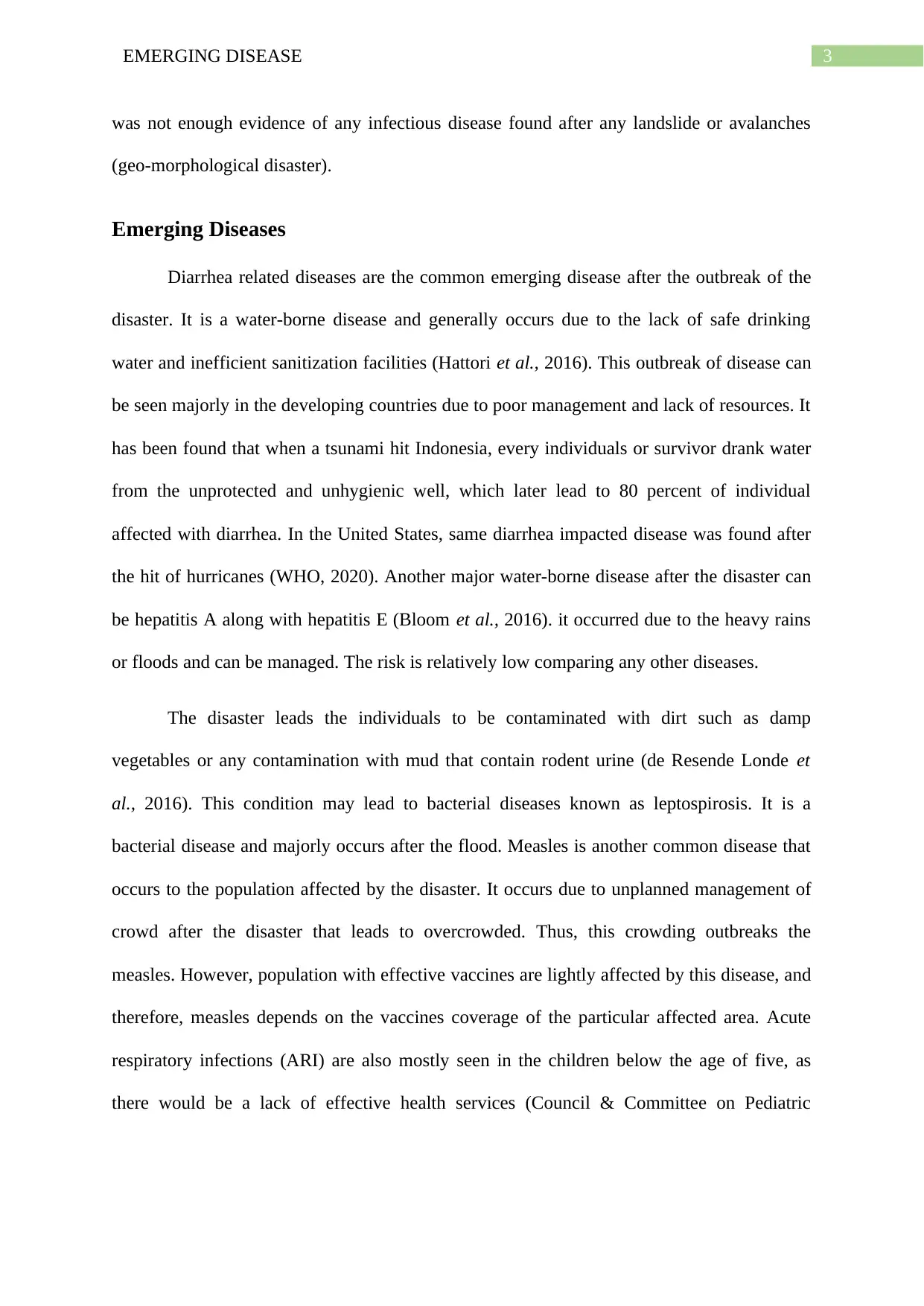
3EMERGING DISEASE
was not enough evidence of any infectious disease found after any landslide or avalanches
(geo-morphological disaster).
Emerging Diseases
Diarrhea related diseases are the common emerging disease after the outbreak of the
disaster. It is a water-borne disease and generally occurs due to the lack of safe drinking
water and inefficient sanitization facilities (Hattori et al., 2016). This outbreak of disease can
be seen majorly in the developing countries due to poor management and lack of resources. It
has been found that when a tsunami hit Indonesia, every individuals or survivor drank water
from the unprotected and unhygienic well, which later lead to 80 percent of individual
affected with diarrhea. In the United States, same diarrhea impacted disease was found after
the hit of hurricanes (WHO, 2020). Another major water-borne disease after the disaster can
be hepatitis A along with hepatitis E (Bloom et al., 2016). it occurred due to the heavy rains
or floods and can be managed. The risk is relatively low comparing any other diseases.
The disaster leads the individuals to be contaminated with dirt such as damp
vegetables or any contamination with mud that contain rodent urine (de Resende Londe et
al., 2016). This condition may lead to bacterial diseases known as leptospirosis. It is a
bacterial disease and majorly occurs after the flood. Measles is another common disease that
occurs to the population affected by the disaster. It occurs due to unplanned management of
crowd after the disaster that leads to overcrowded. Thus, this crowding outbreaks the
measles. However, population with effective vaccines are lightly affected by this disease, and
therefore, measles depends on the vaccines coverage of the particular affected area. Acute
respiratory infections (ARI) are also mostly seen in the children below the age of five, as
there would be a lack of effective health services (Council & Committee on Pediatric
was not enough evidence of any infectious disease found after any landslide or avalanches
(geo-morphological disaster).
Emerging Diseases
Diarrhea related diseases are the common emerging disease after the outbreak of the
disaster. It is a water-borne disease and generally occurs due to the lack of safe drinking
water and inefficient sanitization facilities (Hattori et al., 2016). This outbreak of disease can
be seen majorly in the developing countries due to poor management and lack of resources. It
has been found that when a tsunami hit Indonesia, every individuals or survivor drank water
from the unprotected and unhygienic well, which later lead to 80 percent of individual
affected with diarrhea. In the United States, same diarrhea impacted disease was found after
the hit of hurricanes (WHO, 2020). Another major water-borne disease after the disaster can
be hepatitis A along with hepatitis E (Bloom et al., 2016). it occurred due to the heavy rains
or floods and can be managed. The risk is relatively low comparing any other diseases.
The disaster leads the individuals to be contaminated with dirt such as damp
vegetables or any contamination with mud that contain rodent urine (de Resende Londe et
al., 2016). This condition may lead to bacterial diseases known as leptospirosis. It is a
bacterial disease and majorly occurs after the flood. Measles is another common disease that
occurs to the population affected by the disaster. It occurs due to unplanned management of
crowd after the disaster that leads to overcrowded. Thus, this crowding outbreaks the
measles. However, population with effective vaccines are lightly affected by this disease, and
therefore, measles depends on the vaccines coverage of the particular affected area. Acute
respiratory infections (ARI) are also mostly seen in the children below the age of five, as
there would be a lack of effective health services (Council & Committee on Pediatric
Paraphrase This Document
Need a fresh take? Get an instant paraphrase of this document with our AI Paraphraser
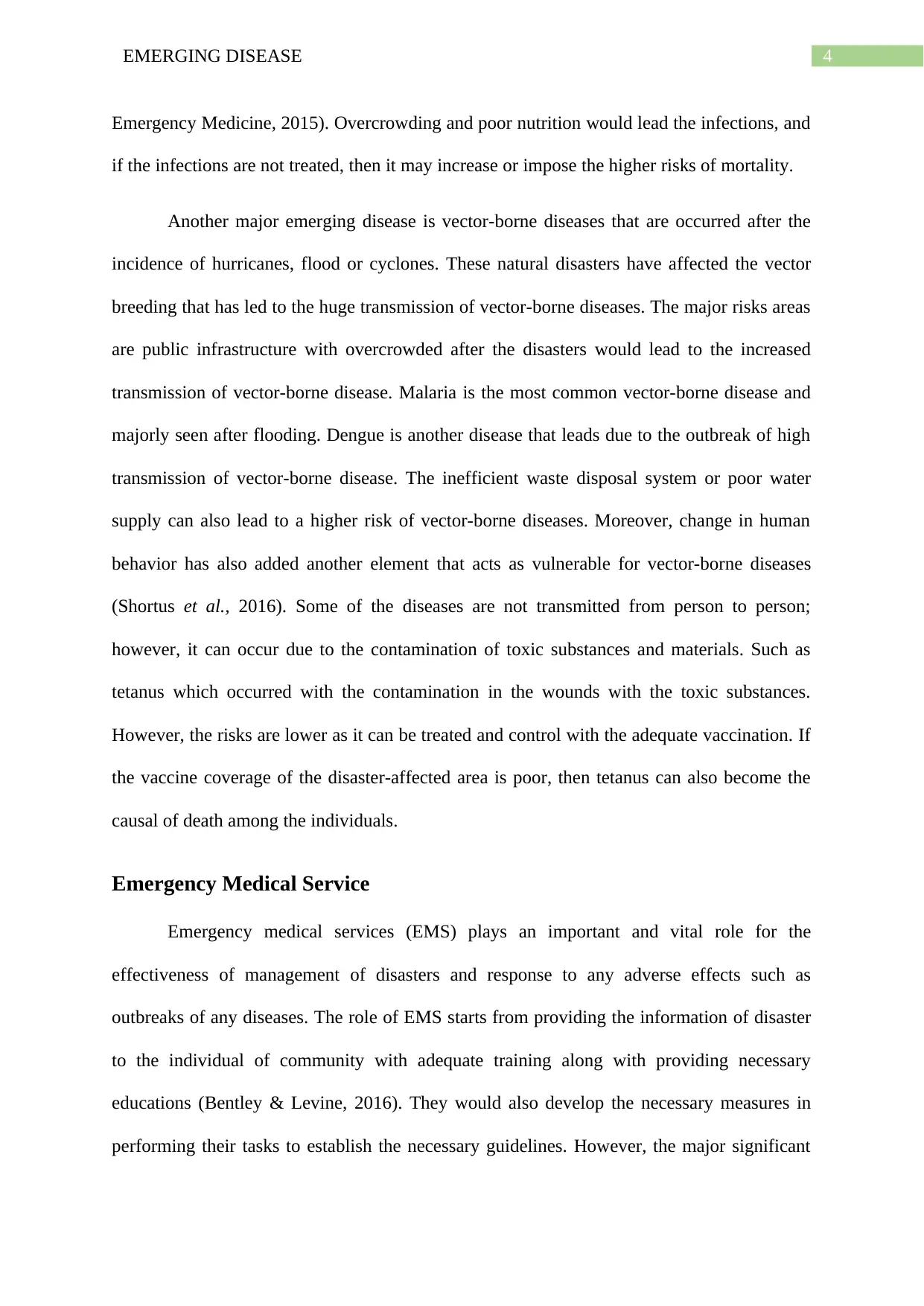
4EMERGING DISEASE
Emergency Medicine, 2015). Overcrowding and poor nutrition would lead the infections, and
if the infections are not treated, then it may increase or impose the higher risks of mortality.
Another major emerging disease is vector-borne diseases that are occurred after the
incidence of hurricanes, flood or cyclones. These natural disasters have affected the vector
breeding that has led to the huge transmission of vector-borne diseases. The major risks areas
are public infrastructure with overcrowded after the disasters would lead to the increased
transmission of vector-borne disease. Malaria is the most common vector-borne disease and
majorly seen after flooding. Dengue is another disease that leads due to the outbreak of high
transmission of vector-borne disease. The inefficient waste disposal system or poor water
supply can also lead to a higher risk of vector-borne diseases. Moreover, change in human
behavior has also added another element that acts as vulnerable for vector-borne diseases
(Shortus et al., 2016). Some of the diseases are not transmitted from person to person;
however, it can occur due to the contamination of toxic substances and materials. Such as
tetanus which occurred with the contamination in the wounds with the toxic substances.
However, the risks are lower as it can be treated and control with the adequate vaccination. If
the vaccine coverage of the disaster-affected area is poor, then tetanus can also become the
causal of death among the individuals.
Emergency Medical Service
Emergency medical services (EMS) plays an important and vital role for the
effectiveness of management of disasters and response to any adverse effects such as
outbreaks of any diseases. The role of EMS starts from providing the information of disaster
to the individual of community with adequate training along with providing necessary
educations (Bentley & Levine, 2016). They would also develop the necessary measures in
performing their tasks to establish the necessary guidelines. However, the major significant
Emergency Medicine, 2015). Overcrowding and poor nutrition would lead the infections, and
if the infections are not treated, then it may increase or impose the higher risks of mortality.
Another major emerging disease is vector-borne diseases that are occurred after the
incidence of hurricanes, flood or cyclones. These natural disasters have affected the vector
breeding that has led to the huge transmission of vector-borne diseases. The major risks areas
are public infrastructure with overcrowded after the disasters would lead to the increased
transmission of vector-borne disease. Malaria is the most common vector-borne disease and
majorly seen after flooding. Dengue is another disease that leads due to the outbreak of high
transmission of vector-borne disease. The inefficient waste disposal system or poor water
supply can also lead to a higher risk of vector-borne diseases. Moreover, change in human
behavior has also added another element that acts as vulnerable for vector-borne diseases
(Shortus et al., 2016). Some of the diseases are not transmitted from person to person;
however, it can occur due to the contamination of toxic substances and materials. Such as
tetanus which occurred with the contamination in the wounds with the toxic substances.
However, the risks are lower as it can be treated and control with the adequate vaccination. If
the vaccine coverage of the disaster-affected area is poor, then tetanus can also become the
causal of death among the individuals.
Emergency Medical Service
Emergency medical services (EMS) plays an important and vital role for the
effectiveness of management of disasters and response to any adverse effects such as
outbreaks of any diseases. The role of EMS starts from providing the information of disaster
to the individual of community with adequate training along with providing necessary
educations (Bentley & Levine, 2016). They would also develop the necessary measures in
performing their tasks to establish the necessary guidelines. However, the major significant
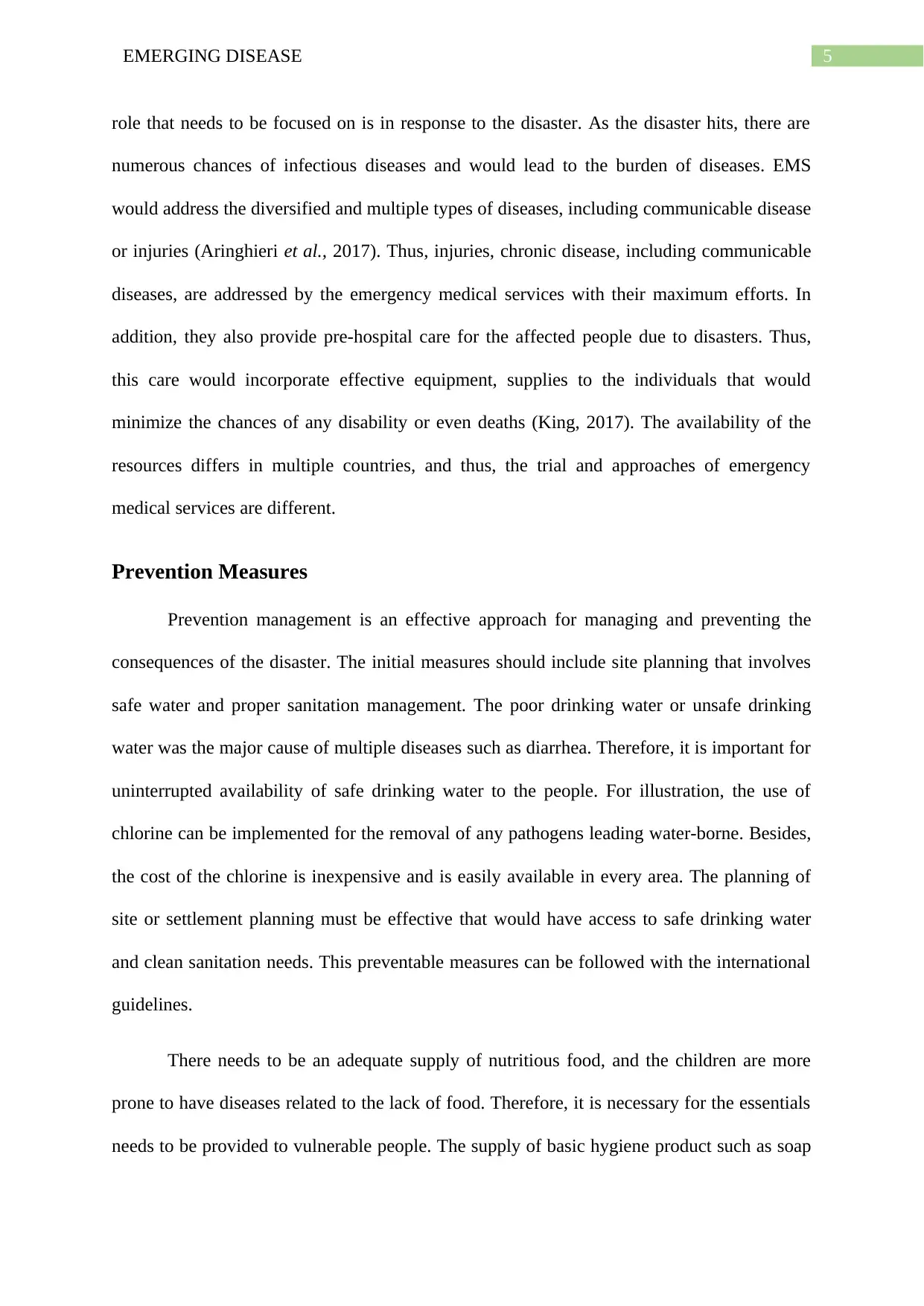
5EMERGING DISEASE
role that needs to be focused on is in response to the disaster. As the disaster hits, there are
numerous chances of infectious diseases and would lead to the burden of diseases. EMS
would address the diversified and multiple types of diseases, including communicable disease
or injuries (Aringhieri et al., 2017). Thus, injuries, chronic disease, including communicable
diseases, are addressed by the emergency medical services with their maximum efforts. In
addition, they also provide pre-hospital care for the affected people due to disasters. Thus,
this care would incorporate effective equipment, supplies to the individuals that would
minimize the chances of any disability or even deaths (King, 2017). The availability of the
resources differs in multiple countries, and thus, the trial and approaches of emergency
medical services are different.
Prevention Measures
Prevention management is an effective approach for managing and preventing the
consequences of the disaster. The initial measures should include site planning that involves
safe water and proper sanitation management. The poor drinking water or unsafe drinking
water was the major cause of multiple diseases such as diarrhea. Therefore, it is important for
uninterrupted availability of safe drinking water to the people. For illustration, the use of
chlorine can be implemented for the removal of any pathogens leading water-borne. Besides,
the cost of the chlorine is inexpensive and is easily available in every area. The planning of
site or settlement planning must be effective that would have access to safe drinking water
and clean sanitation needs. This preventable measures can be followed with the international
guidelines.
There needs to be an adequate supply of nutritious food, and the children are more
prone to have diseases related to the lack of food. Therefore, it is necessary for the essentials
needs to be provided to vulnerable people. The supply of basic hygiene product such as soap
role that needs to be focused on is in response to the disaster. As the disaster hits, there are
numerous chances of infectious diseases and would lead to the burden of diseases. EMS
would address the diversified and multiple types of diseases, including communicable disease
or injuries (Aringhieri et al., 2017). Thus, injuries, chronic disease, including communicable
diseases, are addressed by the emergency medical services with their maximum efforts. In
addition, they also provide pre-hospital care for the affected people due to disasters. Thus,
this care would incorporate effective equipment, supplies to the individuals that would
minimize the chances of any disability or even deaths (King, 2017). The availability of the
resources differs in multiple countries, and thus, the trial and approaches of emergency
medical services are different.
Prevention Measures
Prevention management is an effective approach for managing and preventing the
consequences of the disaster. The initial measures should include site planning that involves
safe water and proper sanitation management. The poor drinking water or unsafe drinking
water was the major cause of multiple diseases such as diarrhea. Therefore, it is important for
uninterrupted availability of safe drinking water to the people. For illustration, the use of
chlorine can be implemented for the removal of any pathogens leading water-borne. Besides,
the cost of the chlorine is inexpensive and is easily available in every area. The planning of
site or settlement planning must be effective that would have access to safe drinking water
and clean sanitation needs. This preventable measures can be followed with the international
guidelines.
There needs to be an adequate supply of nutritious food, and the children are more
prone to have diseases related to the lack of food. Therefore, it is necessary for the essentials
needs to be provided to vulnerable people. The supply of basic hygiene product such as soap
⊘ This is a preview!⊘
Do you want full access?
Subscribe today to unlock all pages.

Trusted by 1+ million students worldwide
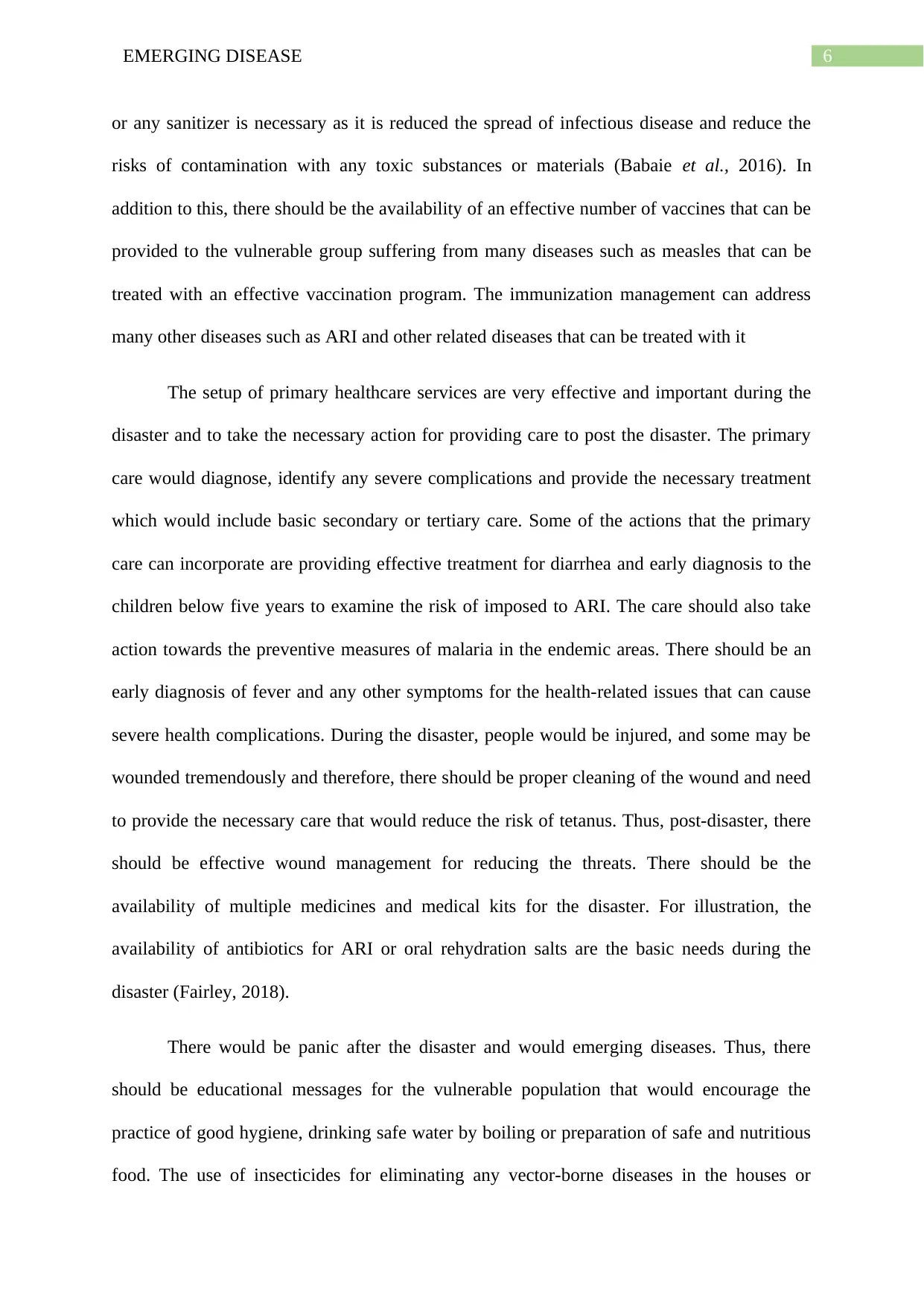
6EMERGING DISEASE
or any sanitizer is necessary as it is reduced the spread of infectious disease and reduce the
risks of contamination with any toxic substances or materials (Babaie et al., 2016). In
addition to this, there should be the availability of an effective number of vaccines that can be
provided to the vulnerable group suffering from many diseases such as measles that can be
treated with an effective vaccination program. The immunization management can address
many other diseases such as ARI and other related diseases that can be treated with it
The setup of primary healthcare services are very effective and important during the
disaster and to take the necessary action for providing care to post the disaster. The primary
care would diagnose, identify any severe complications and provide the necessary treatment
which would include basic secondary or tertiary care. Some of the actions that the primary
care can incorporate are providing effective treatment for diarrhea and early diagnosis to the
children below five years to examine the risk of imposed to ARI. The care should also take
action towards the preventive measures of malaria in the endemic areas. There should be an
early diagnosis of fever and any other symptoms for the health-related issues that can cause
severe health complications. During the disaster, people would be injured, and some may be
wounded tremendously and therefore, there should be proper cleaning of the wound and need
to provide the necessary care that would reduce the risk of tetanus. Thus, post-disaster, there
should be effective wound management for reducing the threats. There should be the
availability of multiple medicines and medical kits for the disaster. For illustration, the
availability of antibiotics for ARI or oral rehydration salts are the basic needs during the
disaster (Fairley, 2018).
There would be panic after the disaster and would emerging diseases. Thus, there
should be educational messages for the vulnerable population that would encourage the
practice of good hygiene, drinking safe water by boiling or preparation of safe and nutritious
food. The use of insecticides for eliminating any vector-borne diseases in the houses or
or any sanitizer is necessary as it is reduced the spread of infectious disease and reduce the
risks of contamination with any toxic substances or materials (Babaie et al., 2016). In
addition to this, there should be the availability of an effective number of vaccines that can be
provided to the vulnerable group suffering from many diseases such as measles that can be
treated with an effective vaccination program. The immunization management can address
many other diseases such as ARI and other related diseases that can be treated with it
The setup of primary healthcare services are very effective and important during the
disaster and to take the necessary action for providing care to post the disaster. The primary
care would diagnose, identify any severe complications and provide the necessary treatment
which would include basic secondary or tertiary care. Some of the actions that the primary
care can incorporate are providing effective treatment for diarrhea and early diagnosis to the
children below five years to examine the risk of imposed to ARI. The care should also take
action towards the preventive measures of malaria in the endemic areas. There should be an
early diagnosis of fever and any other symptoms for the health-related issues that can cause
severe health complications. During the disaster, people would be injured, and some may be
wounded tremendously and therefore, there should be proper cleaning of the wound and need
to provide the necessary care that would reduce the risk of tetanus. Thus, post-disaster, there
should be effective wound management for reducing the threats. There should be the
availability of multiple medicines and medical kits for the disaster. For illustration, the
availability of antibiotics for ARI or oral rehydration salts are the basic needs during the
disaster (Fairley, 2018).
There would be panic after the disaster and would emerging diseases. Thus, there
should be educational messages for the vulnerable population that would encourage the
practice of good hygiene, drinking safe water by boiling or preparation of safe and nutritious
food. The use of insecticides for eliminating any vector-borne diseases in the houses or
Paraphrase This Document
Need a fresh take? Get an instant paraphrase of this document with our AI Paraphraser
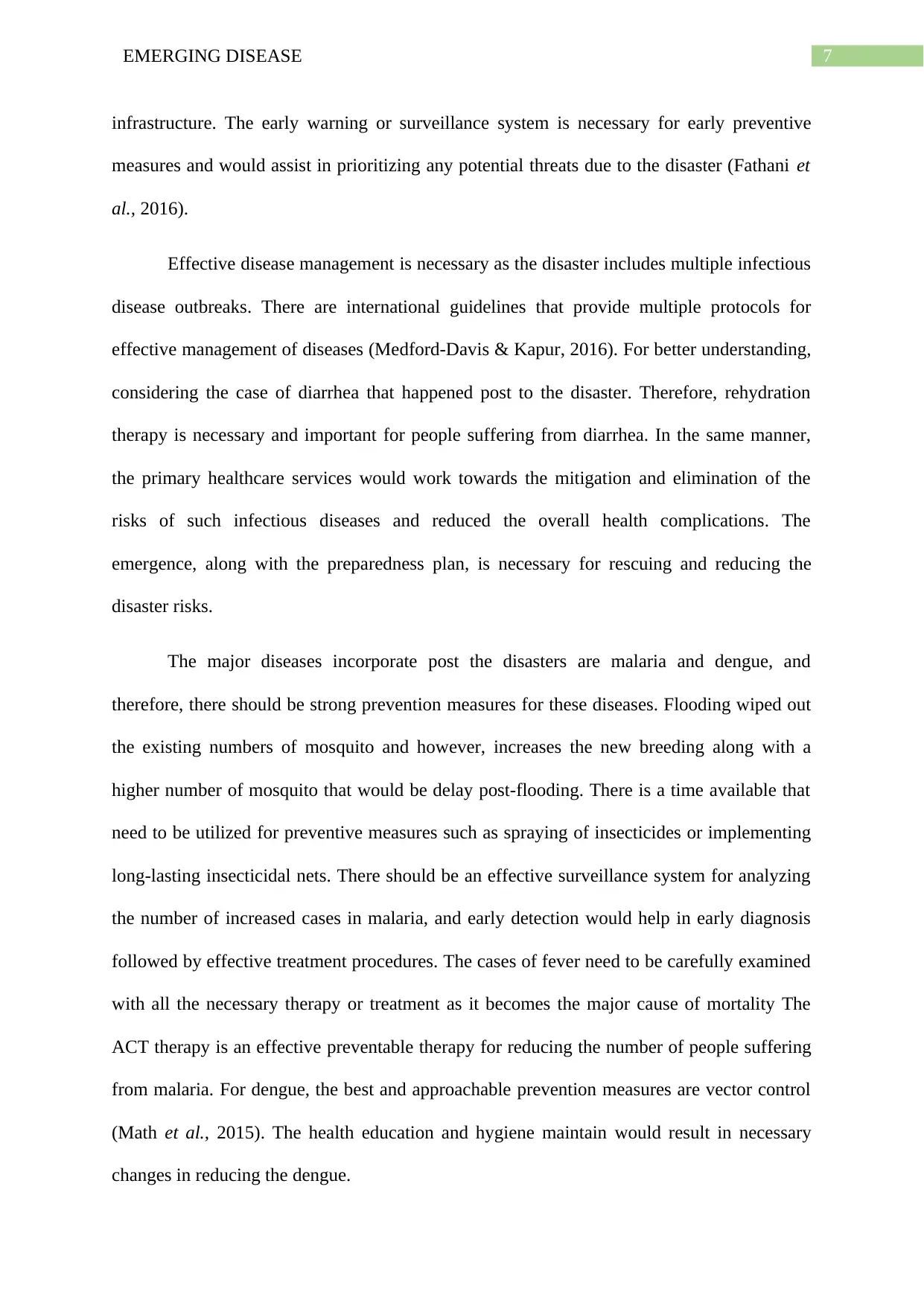
7EMERGING DISEASE
infrastructure. The early warning or surveillance system is necessary for early preventive
measures and would assist in prioritizing any potential threats due to the disaster (Fathani et
al., 2016).
Effective disease management is necessary as the disaster includes multiple infectious
disease outbreaks. There are international guidelines that provide multiple protocols for
effective management of diseases (Medford-Davis & Kapur, 2016). For better understanding,
considering the case of diarrhea that happened post to the disaster. Therefore, rehydration
therapy is necessary and important for people suffering from diarrhea. In the same manner,
the primary healthcare services would work towards the mitigation and elimination of the
risks of such infectious diseases and reduced the overall health complications. The
emergence, along with the preparedness plan, is necessary for rescuing and reducing the
disaster risks.
The major diseases incorporate post the disasters are malaria and dengue, and
therefore, there should be strong prevention measures for these diseases. Flooding wiped out
the existing numbers of mosquito and however, increases the new breeding along with a
higher number of mosquito that would be delay post-flooding. There is a time available that
need to be utilized for preventive measures such as spraying of insecticides or implementing
long-lasting insecticidal nets. There should be an effective surveillance system for analyzing
the number of increased cases in malaria, and early detection would help in early diagnosis
followed by effective treatment procedures. The cases of fever need to be carefully examined
with all the necessary therapy or treatment as it becomes the major cause of mortality The
ACT therapy is an effective preventable therapy for reducing the number of people suffering
from malaria. For dengue, the best and approachable prevention measures are vector control
(Math et al., 2015). The health education and hygiene maintain would result in necessary
changes in reducing the dengue.
infrastructure. The early warning or surveillance system is necessary for early preventive
measures and would assist in prioritizing any potential threats due to the disaster (Fathani et
al., 2016).
Effective disease management is necessary as the disaster includes multiple infectious
disease outbreaks. There are international guidelines that provide multiple protocols for
effective management of diseases (Medford-Davis & Kapur, 2016). For better understanding,
considering the case of diarrhea that happened post to the disaster. Therefore, rehydration
therapy is necessary and important for people suffering from diarrhea. In the same manner,
the primary healthcare services would work towards the mitigation and elimination of the
risks of such infectious diseases and reduced the overall health complications. The
emergence, along with the preparedness plan, is necessary for rescuing and reducing the
disaster risks.
The major diseases incorporate post the disasters are malaria and dengue, and
therefore, there should be strong prevention measures for these diseases. Flooding wiped out
the existing numbers of mosquito and however, increases the new breeding along with a
higher number of mosquito that would be delay post-flooding. There is a time available that
need to be utilized for preventive measures such as spraying of insecticides or implementing
long-lasting insecticidal nets. There should be an effective surveillance system for analyzing
the number of increased cases in malaria, and early detection would help in early diagnosis
followed by effective treatment procedures. The cases of fever need to be carefully examined
with all the necessary therapy or treatment as it becomes the major cause of mortality The
ACT therapy is an effective preventable therapy for reducing the number of people suffering
from malaria. For dengue, the best and approachable prevention measures are vector control
(Math et al., 2015). The health education and hygiene maintain would result in necessary
changes in reducing the dengue.
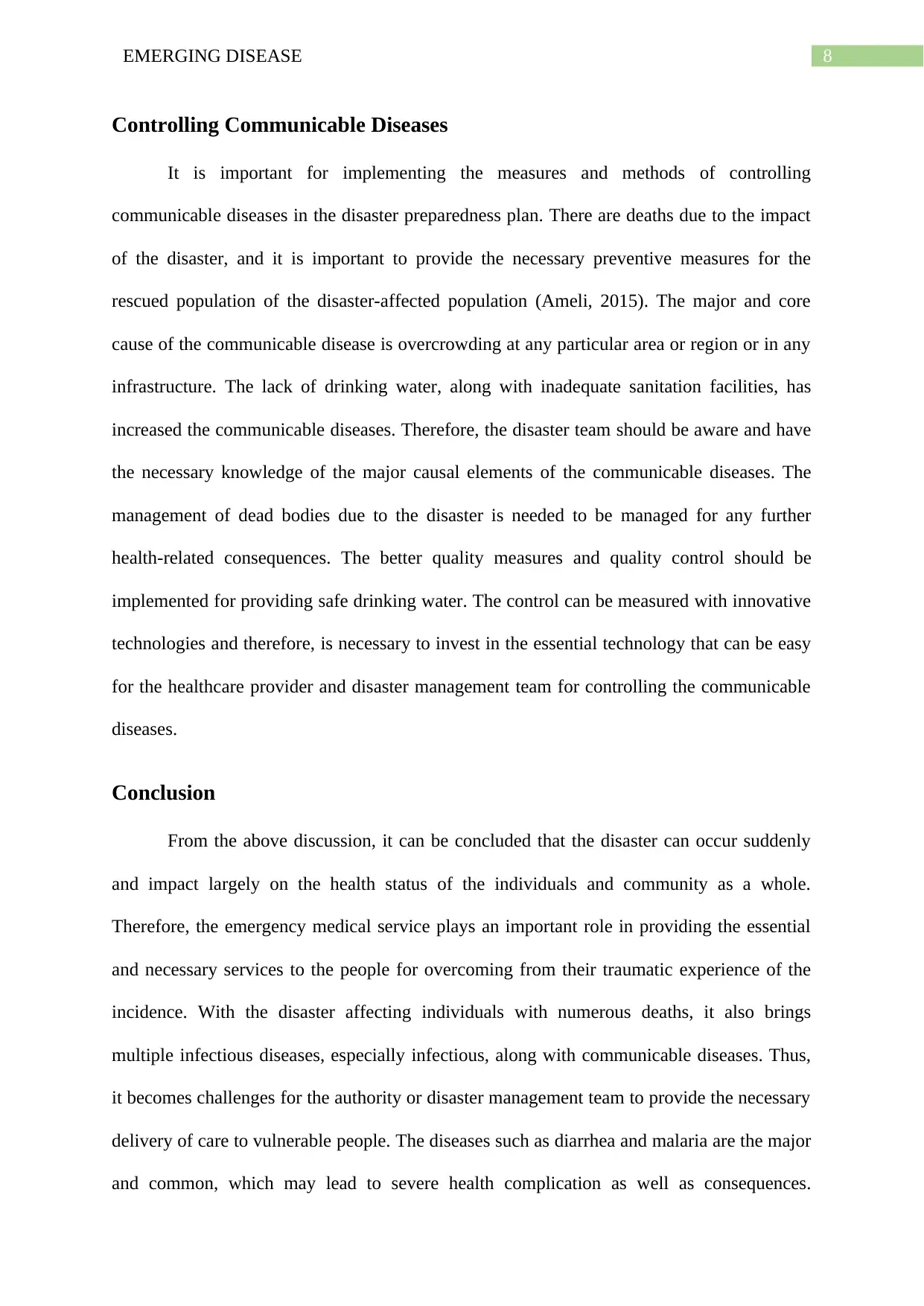
8EMERGING DISEASE
Controlling Communicable Diseases
It is important for implementing the measures and methods of controlling
communicable diseases in the disaster preparedness plan. There are deaths due to the impact
of the disaster, and it is important to provide the necessary preventive measures for the
rescued population of the disaster-affected population (Ameli, 2015). The major and core
cause of the communicable disease is overcrowding at any particular area or region or in any
infrastructure. The lack of drinking water, along with inadequate sanitation facilities, has
increased the communicable diseases. Therefore, the disaster team should be aware and have
the necessary knowledge of the major causal elements of the communicable diseases. The
management of dead bodies due to the disaster is needed to be managed for any further
health-related consequences. The better quality measures and quality control should be
implemented for providing safe drinking water. The control can be measured with innovative
technologies and therefore, is necessary to invest in the essential technology that can be easy
for the healthcare provider and disaster management team for controlling the communicable
diseases.
Conclusion
From the above discussion, it can be concluded that the disaster can occur suddenly
and impact largely on the health status of the individuals and community as a whole.
Therefore, the emergency medical service plays an important role in providing the essential
and necessary services to the people for overcoming from their traumatic experience of the
incidence. With the disaster affecting individuals with numerous deaths, it also brings
multiple infectious diseases, especially infectious, along with communicable diseases. Thus,
it becomes challenges for the authority or disaster management team to provide the necessary
delivery of care to vulnerable people. The diseases such as diarrhea and malaria are the major
and common, which may lead to severe health complication as well as consequences.
Controlling Communicable Diseases
It is important for implementing the measures and methods of controlling
communicable diseases in the disaster preparedness plan. There are deaths due to the impact
of the disaster, and it is important to provide the necessary preventive measures for the
rescued population of the disaster-affected population (Ameli, 2015). The major and core
cause of the communicable disease is overcrowding at any particular area or region or in any
infrastructure. The lack of drinking water, along with inadequate sanitation facilities, has
increased the communicable diseases. Therefore, the disaster team should be aware and have
the necessary knowledge of the major causal elements of the communicable diseases. The
management of dead bodies due to the disaster is needed to be managed for any further
health-related consequences. The better quality measures and quality control should be
implemented for providing safe drinking water. The control can be measured with innovative
technologies and therefore, is necessary to invest in the essential technology that can be easy
for the healthcare provider and disaster management team for controlling the communicable
diseases.
Conclusion
From the above discussion, it can be concluded that the disaster can occur suddenly
and impact largely on the health status of the individuals and community as a whole.
Therefore, the emergency medical service plays an important role in providing the essential
and necessary services to the people for overcoming from their traumatic experience of the
incidence. With the disaster affecting individuals with numerous deaths, it also brings
multiple infectious diseases, especially infectious, along with communicable diseases. Thus,
it becomes challenges for the authority or disaster management team to provide the necessary
delivery of care to vulnerable people. The diseases such as diarrhea and malaria are the major
and common, which may lead to severe health complication as well as consequences.
⊘ This is a preview!⊘
Do you want full access?
Subscribe today to unlock all pages.

Trusted by 1+ million students worldwide
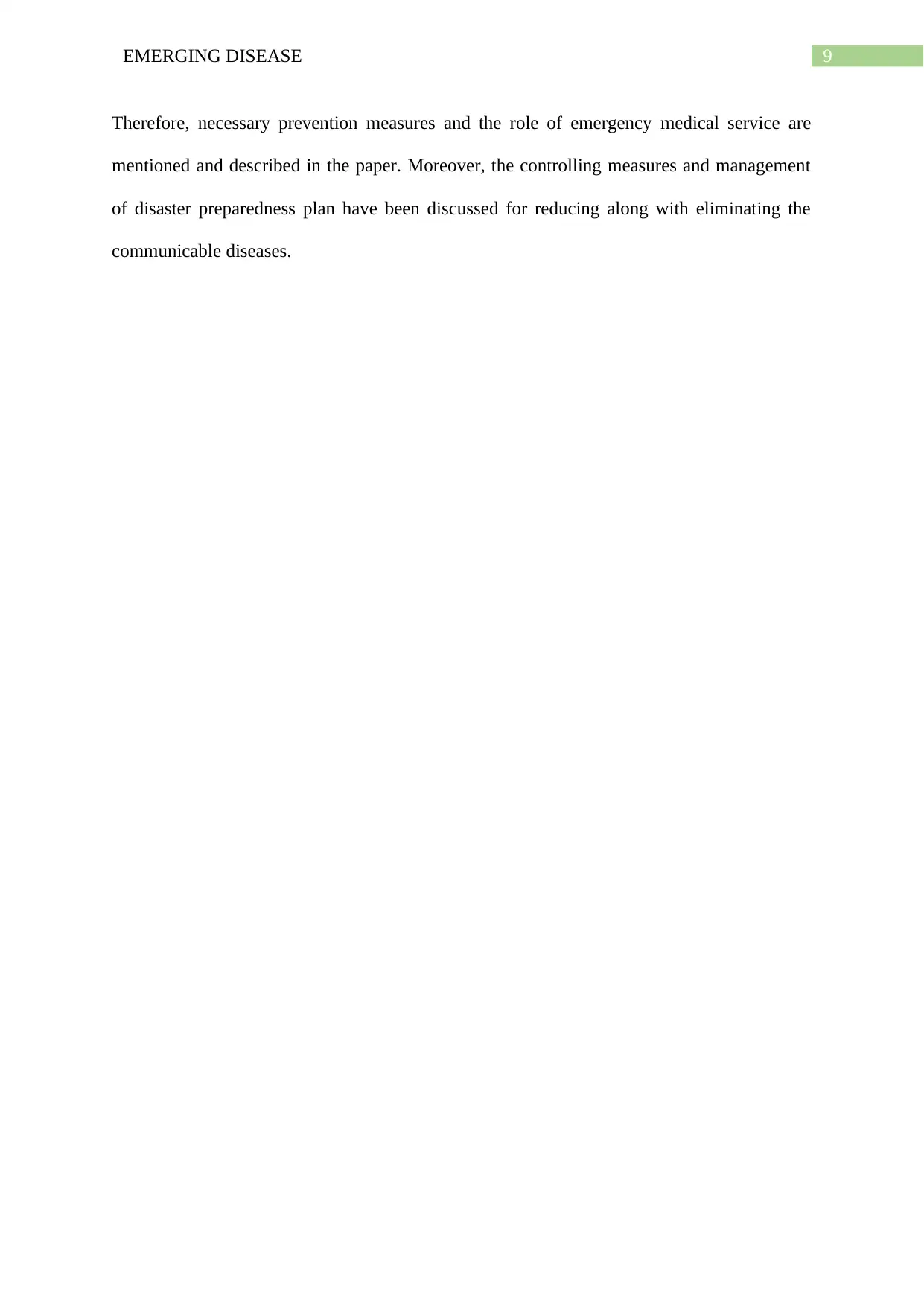
9EMERGING DISEASE
Therefore, necessary prevention measures and the role of emergency medical service are
mentioned and described in the paper. Moreover, the controlling measures and management
of disaster preparedness plan have been discussed for reducing along with eliminating the
communicable diseases.
Therefore, necessary prevention measures and the role of emergency medical service are
mentioned and described in the paper. Moreover, the controlling measures and management
of disaster preparedness plan have been discussed for reducing along with eliminating the
communicable diseases.
Paraphrase This Document
Need a fresh take? Get an instant paraphrase of this document with our AI Paraphraser
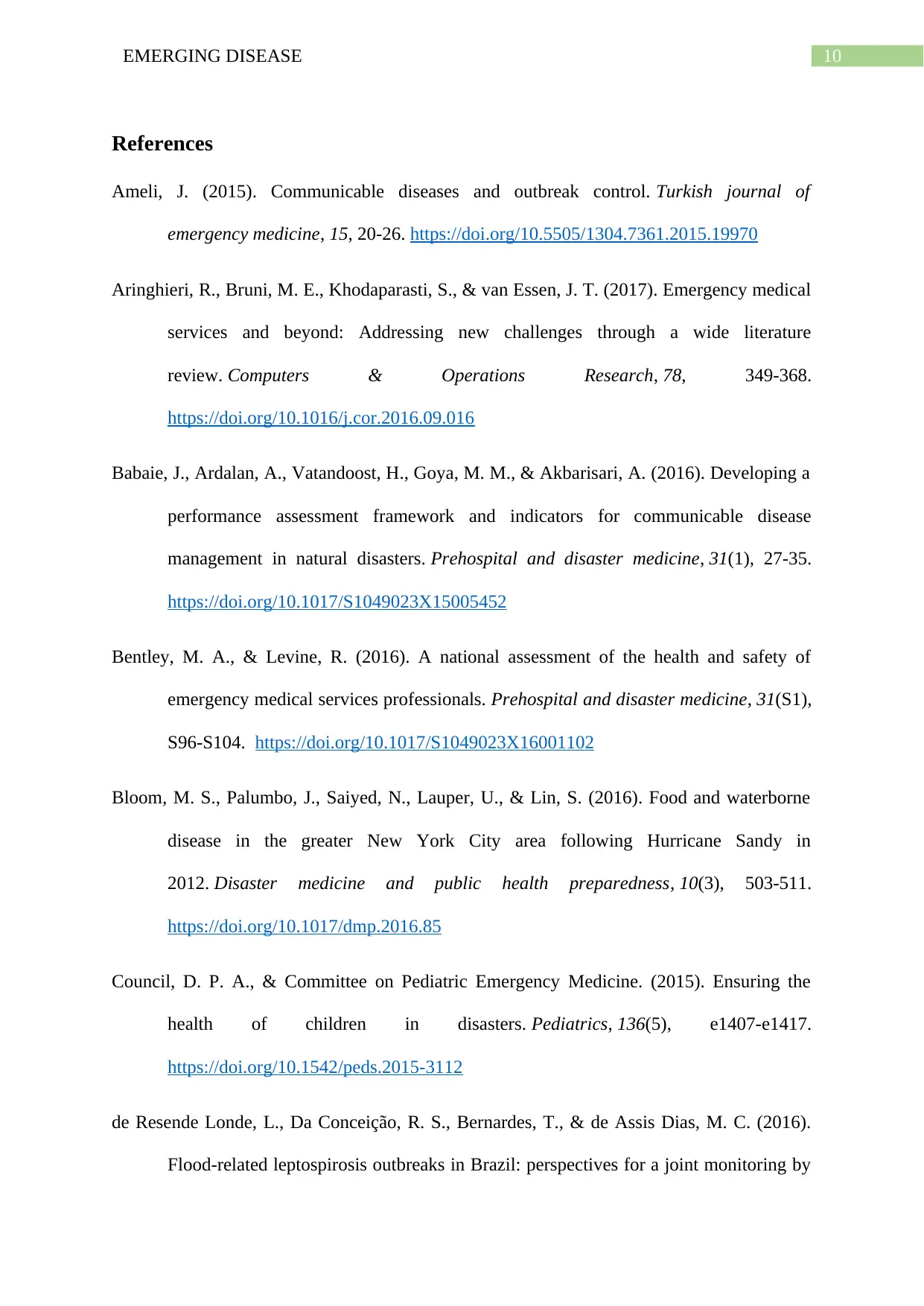
10EMERGING DISEASE
References
Ameli, J. (2015). Communicable diseases and outbreak control. Turkish journal of
emergency medicine, 15, 20-26. https://doi.org/10.5505/1304.7361.2015.19970
Aringhieri, R., Bruni, M. E., Khodaparasti, S., & van Essen, J. T. (2017). Emergency medical
services and beyond: Addressing new challenges through a wide literature
review. Computers & Operations Research, 78, 349-368.
https://doi.org/10.1016/j.cor.2016.09.016
Babaie, J., Ardalan, A., Vatandoost, H., Goya, M. M., & Akbarisari, A. (2016). Developing a
performance assessment framework and indicators for communicable disease
management in natural disasters. Prehospital and disaster medicine, 31(1), 27-35.
https://doi.org/10.1017/S1049023X15005452
Bentley, M. A., & Levine, R. (2016). A national assessment of the health and safety of
emergency medical services professionals. Prehospital and disaster medicine, 31(S1),
S96-S104. https://doi.org/10.1017/S1049023X16001102
Bloom, M. S., Palumbo, J., Saiyed, N., Lauper, U., & Lin, S. (2016). Food and waterborne
disease in the greater New York City area following Hurricane Sandy in
2012. Disaster medicine and public health preparedness, 10(3), 503-511.
https://doi.org/10.1017/dmp.2016.85
Council, D. P. A., & Committee on Pediatric Emergency Medicine. (2015). Ensuring the
health of children in disasters. Pediatrics, 136(5), e1407-e1417.
https://doi.org/10.1542/peds.2015-3112
de Resende Londe, L., Da Conceição, R. S., Bernardes, T., & de Assis Dias, M. C. (2016).
Flood-related leptospirosis outbreaks in Brazil: perspectives for a joint monitoring by
References
Ameli, J. (2015). Communicable diseases and outbreak control. Turkish journal of
emergency medicine, 15, 20-26. https://doi.org/10.5505/1304.7361.2015.19970
Aringhieri, R., Bruni, M. E., Khodaparasti, S., & van Essen, J. T. (2017). Emergency medical
services and beyond: Addressing new challenges through a wide literature
review. Computers & Operations Research, 78, 349-368.
https://doi.org/10.1016/j.cor.2016.09.016
Babaie, J., Ardalan, A., Vatandoost, H., Goya, M. M., & Akbarisari, A. (2016). Developing a
performance assessment framework and indicators for communicable disease
management in natural disasters. Prehospital and disaster medicine, 31(1), 27-35.
https://doi.org/10.1017/S1049023X15005452
Bentley, M. A., & Levine, R. (2016). A national assessment of the health and safety of
emergency medical services professionals. Prehospital and disaster medicine, 31(S1),
S96-S104. https://doi.org/10.1017/S1049023X16001102
Bloom, M. S., Palumbo, J., Saiyed, N., Lauper, U., & Lin, S. (2016). Food and waterborne
disease in the greater New York City area following Hurricane Sandy in
2012. Disaster medicine and public health preparedness, 10(3), 503-511.
https://doi.org/10.1017/dmp.2016.85
Council, D. P. A., & Committee on Pediatric Emergency Medicine. (2015). Ensuring the
health of children in disasters. Pediatrics, 136(5), e1407-e1417.
https://doi.org/10.1542/peds.2015-3112
de Resende Londe, L., Da Conceição, R. S., Bernardes, T., & de Assis Dias, M. C. (2016).
Flood-related leptospirosis outbreaks in Brazil: perspectives for a joint monitoring by
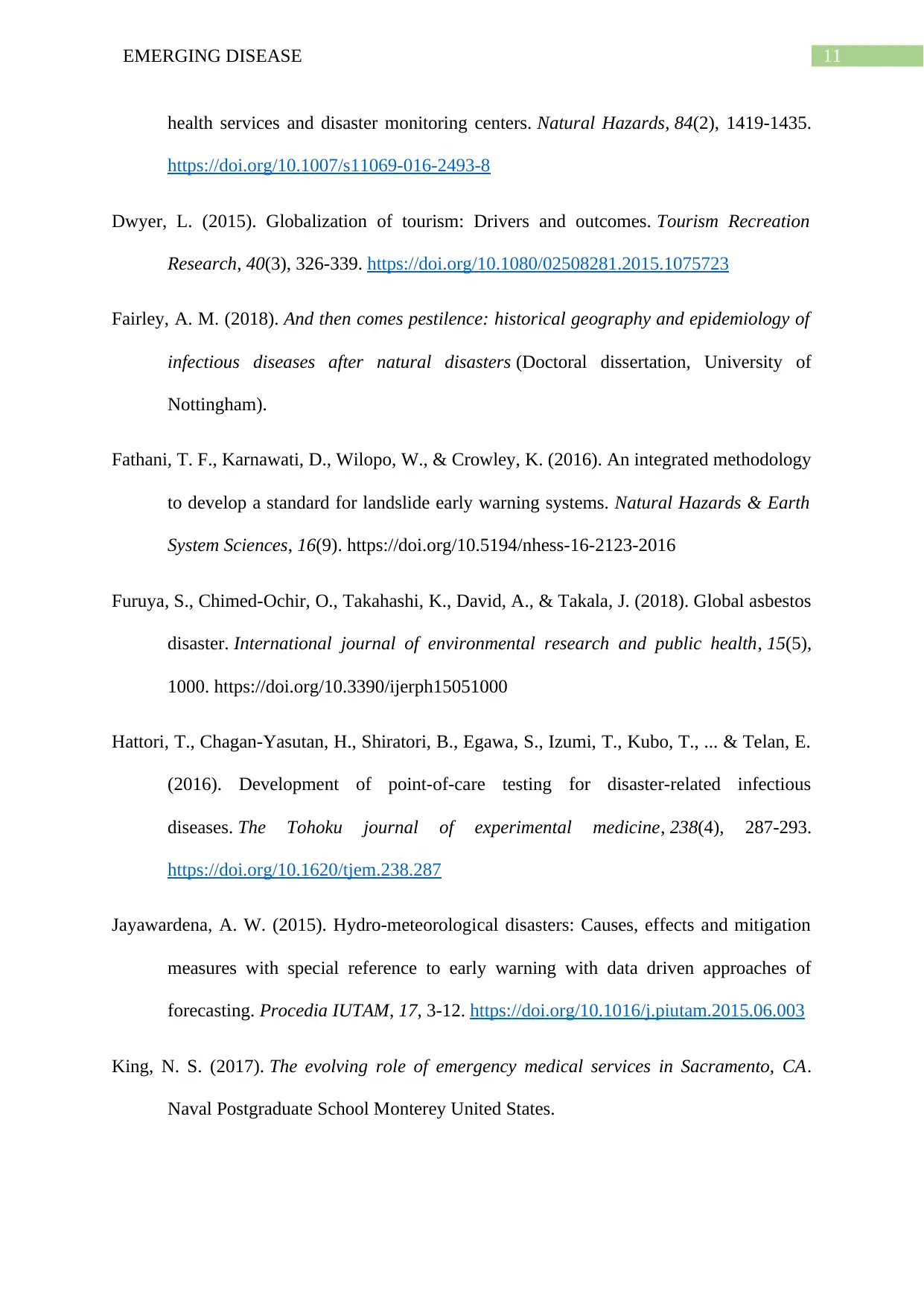
11EMERGING DISEASE
health services and disaster monitoring centers. Natural Hazards, 84(2), 1419-1435.
https://doi.org/10.1007/s11069-016-2493-8
Dwyer, L. (2015). Globalization of tourism: Drivers and outcomes. Tourism Recreation
Research, 40(3), 326-339. https://doi.org/10.1080/02508281.2015.1075723
Fairley, A. M. (2018). And then comes pestilence: historical geography and epidemiology of
infectious diseases after natural disasters (Doctoral dissertation, University of
Nottingham).
Fathani, T. F., Karnawati, D., Wilopo, W., & Crowley, K. (2016). An integrated methodology
to develop a standard for landslide early warning systems. Natural Hazards & Earth
System Sciences, 16(9). https://doi.org/10.5194/nhess-16-2123-2016
Furuya, S., Chimed-Ochir, O., Takahashi, K., David, A., & Takala, J. (2018). Global asbestos
disaster. International journal of environmental research and public health, 15(5),
1000. https://doi.org/10.3390/ijerph15051000
Hattori, T., Chagan-Yasutan, H., Shiratori, B., Egawa, S., Izumi, T., Kubo, T., ... & Telan, E.
(2016). Development of point-of-care testing for disaster-related infectious
diseases. The Tohoku journal of experimental medicine, 238(4), 287-293.
https://doi.org/10.1620/tjem.238.287
Jayawardena, A. W. (2015). Hydro-meteorological disasters: Causes, effects and mitigation
measures with special reference to early warning with data driven approaches of
forecasting. Procedia IUTAM, 17, 3-12. https://doi.org/10.1016/j.piutam.2015.06.003
King, N. S. (2017). The evolving role of emergency medical services in Sacramento, CA.
Naval Postgraduate School Monterey United States.
health services and disaster monitoring centers. Natural Hazards, 84(2), 1419-1435.
https://doi.org/10.1007/s11069-016-2493-8
Dwyer, L. (2015). Globalization of tourism: Drivers and outcomes. Tourism Recreation
Research, 40(3), 326-339. https://doi.org/10.1080/02508281.2015.1075723
Fairley, A. M. (2018). And then comes pestilence: historical geography and epidemiology of
infectious diseases after natural disasters (Doctoral dissertation, University of
Nottingham).
Fathani, T. F., Karnawati, D., Wilopo, W., & Crowley, K. (2016). An integrated methodology
to develop a standard for landslide early warning systems. Natural Hazards & Earth
System Sciences, 16(9). https://doi.org/10.5194/nhess-16-2123-2016
Furuya, S., Chimed-Ochir, O., Takahashi, K., David, A., & Takala, J. (2018). Global asbestos
disaster. International journal of environmental research and public health, 15(5),
1000. https://doi.org/10.3390/ijerph15051000
Hattori, T., Chagan-Yasutan, H., Shiratori, B., Egawa, S., Izumi, T., Kubo, T., ... & Telan, E.
(2016). Development of point-of-care testing for disaster-related infectious
diseases. The Tohoku journal of experimental medicine, 238(4), 287-293.
https://doi.org/10.1620/tjem.238.287
Jayawardena, A. W. (2015). Hydro-meteorological disasters: Causes, effects and mitigation
measures with special reference to early warning with data driven approaches of
forecasting. Procedia IUTAM, 17, 3-12. https://doi.org/10.1016/j.piutam.2015.06.003
King, N. S. (2017). The evolving role of emergency medical services in Sacramento, CA.
Naval Postgraduate School Monterey United States.
⊘ This is a preview!⊘
Do you want full access?
Subscribe today to unlock all pages.

Trusted by 1+ million students worldwide
1 out of 14
Related Documents
Your All-in-One AI-Powered Toolkit for Academic Success.
+13062052269
info@desklib.com
Available 24*7 on WhatsApp / Email
![[object Object]](/_next/static/media/star-bottom.7253800d.svg)
Unlock your academic potential
Copyright © 2020–2025 A2Z Services. All Rights Reserved. Developed and managed by ZUCOL.





